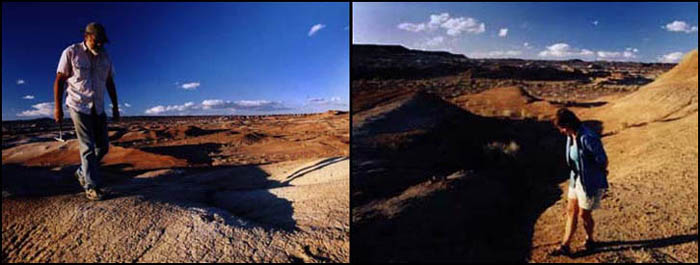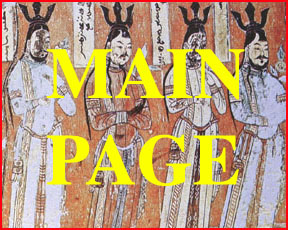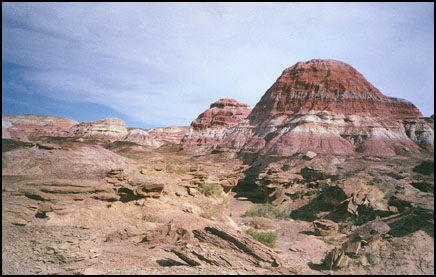
 In 2001 we concentrated our
activities at Wucaiwan ("five colored bend;" see the map
on our main page), an expansive area of outcrops that was explored only briefly
by earlier expeditions (the Chinese Canadian Dinosaur Project called this area Pingfengshan). We worked mainly in the upper
part of the Shishugou Formation, which grades downward into older, unfossiliferous rocks a few kilometers east that are extremely colorful.
Some of these colorful badlands (above) were featured in the desert sequences of the movie Crouching Tiger,
Hidden Dragon (right), and they are visited occasionally by hardy tourists lured by their famously bright colors (the Shishugou
outcrops are thankfully off the tourist track). In August of 2000 we surveyed several potential sites in the Junggar Basin
guided by Dr. Zhao Xi-jing of the IVPP, who has over 25 years of experience collecting dinosaurs in Xinjiang. The Shishugou outcrops at
Wucaiwan appeared to have the greatest potential, based upon our discovery of several small fossils, the extremely broad
exposures of fossiliferous rocks in the area, and the limited prospecting by previous expeditions to the area. Our
expectations were more than realized in 2001, and by the end of the field season we had collected over 40 specimens
including a dozen dinosaurs, most of them including much of the skeleton. These are now being prepared for study at
the IVPP and will be placed in their collections.
In 2001 we concentrated our
activities at Wucaiwan ("five colored bend;" see the map
on our main page), an expansive area of outcrops that was explored only briefly
by earlier expeditions (the Chinese Canadian Dinosaur Project called this area Pingfengshan). We worked mainly in the upper
part of the Shishugou Formation, which grades downward into older, unfossiliferous rocks a few kilometers east that are extremely colorful.
Some of these colorful badlands (above) were featured in the desert sequences of the movie Crouching Tiger,
Hidden Dragon (right), and they are visited occasionally by hardy tourists lured by their famously bright colors (the Shishugou
outcrops are thankfully off the tourist track). In August of 2000 we surveyed several potential sites in the Junggar Basin
guided by Dr. Zhao Xi-jing of the IVPP, who has over 25 years of experience collecting dinosaurs in Xinjiang. The Shishugou outcrops at
Wucaiwan appeared to have the greatest potential, based upon our discovery of several small fossils, the extremely broad
exposures of fossiliferous rocks in the area, and the limited prospecting by previous expeditions to the area. Our
expectations were more than realized in 2001, and by the end of the field season we had collected over 40 specimens
including a dozen dinosaurs, most of them including much of the skeleton. These are now being prepared for study at
the IVPP and will be placed in their collections.
During the 2001 field season Director Zhu Min of the IVPP visited Xinjiang and signed a three year agreement with the Changji Autonomous Prefecture to cooperate on the collection of fossil vertebrates within the prefecture. The Changji Prefecture is planning to erect a museum including dinosaurs from the Shishugou Formation, and we will be helping them find fossils for the museum.
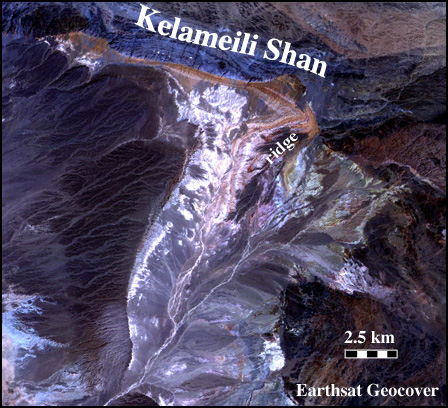
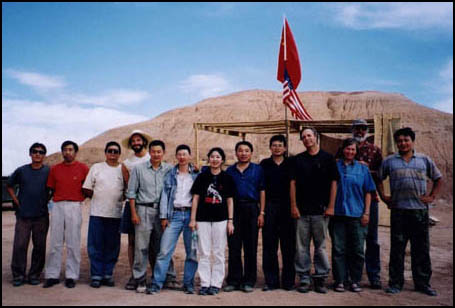

A welcoming feast - When the group first arrived in Xinjiang we were treated by our hosts in Changji to a visit to Tianchi, the "heavenly lake," high in the Tianshan Mountains. The highlight was lunch in a Kazakh yurt, which included the whole roasted goat whose head is visible above. Brian Andres and Nick Frankfurt were ceremoniously requested to eat the two ears, to symbolize that as young students they should listen to their elders. Here Brian, left, tries to wash the ear down with some salty milk tea.


Base camp, looking north - The team used this base camp in Wucaiwan for the duration of the work, sleeping in individual tents such as those in the background (the Kelameili Shan is on the horizon behind them). Thanks to the shopping efforts of Wang Hai-jun and Huo Yu-long, the expedition was very well equipped. An electric generator positioned on the other side of a hill provided power for a freezer and other modern conveniences, stored in this sturdy wooden hut. A tape player emanated music ranging from "Guns 'N Roses Live" to traditional music of Xinjiang and a performance by a comedic storyteller and percussionist from Gansu. Two dozen roosters and two sheep were kept in camp to provide fresh food, although one sheep got loose and a chicken disappeared one night; both probably fell victim to wolves, whose yelps we occasionally heard in the distance. Our cook, Zhou Quan, prepared exquisite food here, often serving six or seven course meals, and Zhou found some nice fossils as well.

A small fossil weathering out of the ground - The white particles in the center of this photo are from small bones, their size indicated by the tip of a rock hammer on the left. Further excavation revealed the broken teeth of a tritylodontid mammal-like reptile, a distant relative of living mammals. Tritylodonts proved to be surprisingly common in the upper Shishugou deposits at Wucaiwan even though they had never been reported from that part of the formation before. The expedition collected several skulls and skeletons of two different kinds: to see a picture of a tritylodont skull we found later that summer, click on the image.

A turtle shell collected by the expedition - Turtles are abundant at Wucaiwan, but most we found were not as complete as this specimen discovered by Cathy, which preserved limb bones. It appears to represent a new species, as the only turtle reported from the Shishugou before does not have sculpturing like this shell. Most of the fossils were preserved in mudstones such as the one encasing this shell, which was deposited by the flooding of an ancient river over 130 million years ago.

Dinosaur skeleton in plaster jacket - This theropod dinosaur skeleton could not be collected in parts, so one large, heavy jacket had to be taken out of the quarry inside a wooden crate. A path was dug with the jackhammer through the hill and a wire cable pulled by a truck dragged the block in fits and spurts along the path over boards and pipes. On the right, Huo Yu-long, in white, discusses an "exit strategy" with Wang Hai-jun, in blue, while Xu Xing (top) and He Tao (bottom) listen. They worked long and hard into the night to move this important specimen into the truck. Once it was prepared we realized that there were parts of three animals in the block; in addition to the back half of one skeleton there are two more tails, one with disarticulated hindlimbs beneath it. To see what the block looked like once it was cleaned up, click on the image.
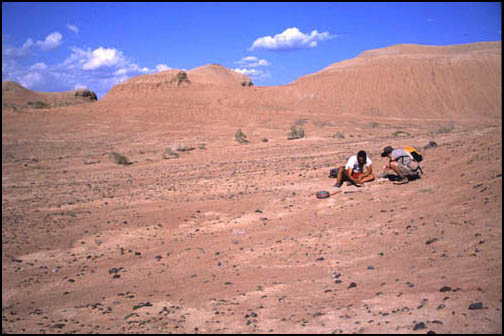
A small plant-eating dinosaur - Brian Andres and Nick Frankfurt begin excavating a small dinosaur that Nick found weathering from the side of this hill south of camp. A jaw with teeth and several other bones of an ornithischian dinosaur, either an ankylosaur or a stegosaur, later emerged from the ground. To see the jaw, click on the image. A small theropod had weathered from the hill about fifty meters to the right of this fossil.
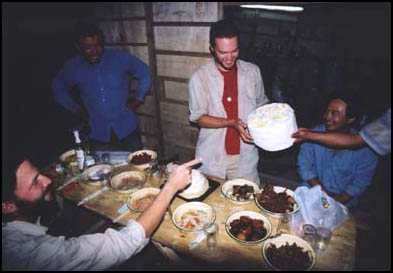
A going away party - Brian Andres left the field at the end of August to teach introductory biology laboratories at GWU, and a party was thrown to see him off. He is holding a fake plaster "cake" placed over the real cake (he figured it out quickly). Brian coined the term "half gam be" (gam be means "bottoms up") to protect himself during the frequent rounds of toasts involving the traditional Chinese liquor bai jiu, a sorghum distillate whose taste the Americans generally failed to appreciate.

A dangerous mammal threatens camp - Small footprints of nocturnal mammals were often found in camp when we arose at dawn, but the appearance one morning of extremely large, wolf-like footprints caused great concern. The discovery of a plaster "paw" (shown below by Cathy), however, soon revealed that a practical joker among us had perpetrated a hoax. The appearance of the tracks coincided with the departure from the field of Chris Sloan, something Chris has yet to fully explain.


A small carnivorous dinosaur - Nick Frankfurt cleans plaster from his arm as he waits for two jackets containing bones of a juvenile carnivorous dinosaur to dry. The large jacket has disarticulated limb bones and vertebrae, and several skull bones are in the jacket at Nick's left foot. More skull bones were later found in the bottom of the pit further to his left and removed in a third jacket. Our initial interpretation of this fossil is that it is from a new coelurosaur - the oldest substantial skeleton of a coelurosaur - fulfilling one of the main goals of our expedition. To see the bones of the skull once they were cleaned up, click on the image.
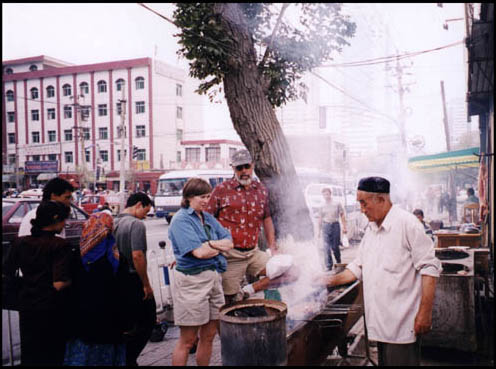
A visit to Urumchi - The capital of Xinjiang, pronounced "wulumuchi" by locals, was a convenient place for supplies and brief respites from the hot desert. Here Jim and Cathy wait for a Uyghur man to cook spicy chunks of lamb over coals, a delicacy known as shashlik. Because all of China is in the same time zone, the official time in Urumchi and the rest of far western China is about two hours later than suggested by the position of the sun. The fossils were crated and shipped at the Urumchi train station.
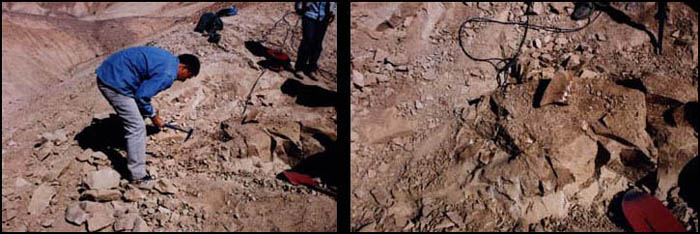
Co-leader Xu Xing quarrying out dinosaur bones - Jackhammers proved useful in quarrying through the hard, fissured rock, the jackhammer bit is visible in the upper right of the right image. The electric power cord in the background extended 30 meters from the generator down the face of a cliff to reach the quarry. We collected many isolated bones of a medium sized plant-eating dinosaur from this quarry in the northern part of the Wucaiwan basin and two others nearby in the last days of the expedition, while we each pondered the events of September 11 as related by Chinese radio.
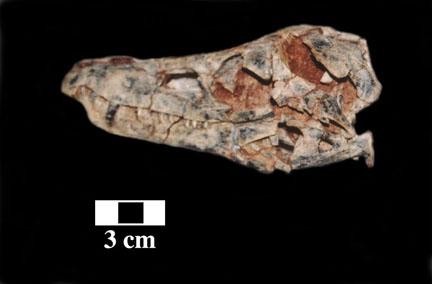
A prized specimen - Chris Sloan found this beautiful skull of a sphenosuchian crocodylomorph in the lower part of the Shishugou Formation, the latest occurrence for this group anywhere in the world. It was attached to the front half of a skeleton, which surprisingly has vertebrae very similar to those of living crocodylians. It represents a new species related to the Early Jurassic Dibothrosuchus from southern China. Not too far from this Chris also found some bones of a pterodactyl, the oldest occurrence for this group.
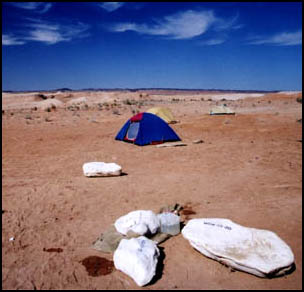
Jacketed specimens in camp - The sign of a successful expedition: jacketed specimens littering the ground. We found so many specimens that three trips to Urumchi were necessary to ship them off to Beijing. Each specimen was labeled with a field number, and a GPS position was taken for every one.

A banquet to celebrate a successful field season - He Tao and Huo Yu-long (who bears an uncanny resemblance here to Drew Carey) feast on roast duck, carved by the chef in the left background, and other delicious food at a banquet in Beijing with our advisor, Professor Zhao, to celebrate our success. The fossils arrived in Beijing by train during the month after we left the field.
